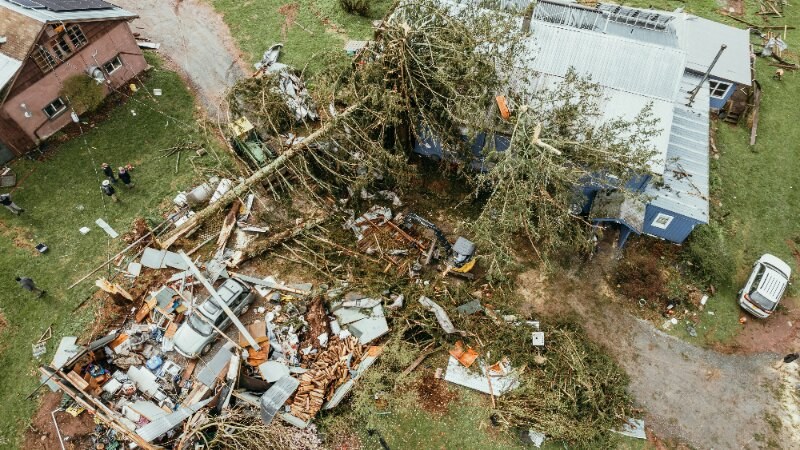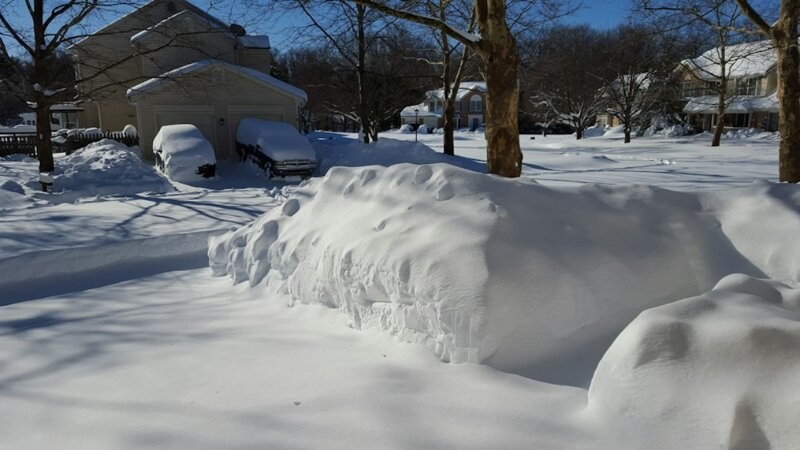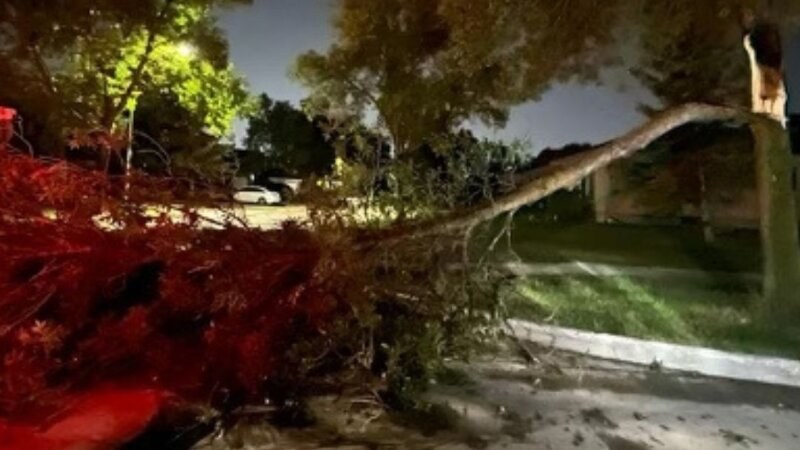Regina Edition: How to Clean Up Your Yard and Trees After a Storm
Reading time: 8 minutesWe get it – waking up to a garden that looks more like a battlefield than a backyard can be unnerving.
But here in Regina, we’re accustomed to the weather keeping us on our toes, although a storm's aftermath leaves us wondering whether our yards will ever look the same.
Don’t worry, though, we’ve got you. Let's walk through how to clean up your yard and trees.

Safety Before You Dive In
Before you tackle the aftermath head-on, there's a golden rule we can't stress enough: safety comes first. It's easy to rush in, but a few preliminary checks can save a lot of trouble down the line.
Downed Power Lines
Check for any downed power lines lurking in your garden. Those bad boys are dangerous and can turn a good deed into a headline. If you spot any, keep your distance and call the professionals.
Hazardous Debris
Keep your eyes open for sharp branches, broken glass, or anything that looks like it might require a tetanus shot. Arm yourself with gloves, sturdy boots, and a healthy respect for the unpredictable.
Know When To Call In Experts
Remember that some cleanup tasks are better left to those with the tools, training, and insurance to handle them safely. That massive tree limb dangling precariously over your shed? Yeah, that's a job for the experts.
Always Wait It Out
Give hazardous conditions some time to calm down before you start thinking about clean-up. Sometimes, the best action is inaction. Storms can leave behind a bit of an aftermath, and it’s wise to wait for the all-clear before jumping into cleanup mode.
Cleaning Up Your Lawn After a Storm

So, you’ve taken the safety precautions and are now ready to jump into the clean-up. Here's how to turn your lawn from 'aftermath' to 'afterglow' in six manageable steps:
Debris Removal
First up, let's clear the stage. Grab your rake, lawn bags, and maybe a leaf blower to show those twigs, leaves, and branches who's boss. Work methodically, clearing one section at a time to avoid feeling overwhelmed. Your yard will thank you, and maybe your muscles will too. Rake up twigs, leaves, and debris. Leaving wet leaves on your lawn for too long may lead to additional lawn damage and diseases. Once raked, dump the leaves in your compost pile.
Damage Assessment
With the debris out of the way, it's time for a closer look at your lawn. Inspect your lawn for signs of damage, like uprooted areas or soil that's been packed down hard. These spots need a bit more attention to bounce back, so make a note of where the trouble zones are. Identifying these early means you can tailor your recovery efforts for maximum impact.
In addition to your lawn, also check your trees. Frequently, due to the storm's intensity, your tree’s roots may weaken, making the tree a hazard. It’s best to call in professionals for an emergency tree assessment because they’ll be able to see signs that an untrained eye might miss.

Check Drainage
The City of Regina uses above and below-ground storm sewer pipes to collect rain and snowmelt for appropriate drainage. This is done to protect against instances of flooding.
Here are some flood protection tips for your property:
- Extend all downspouts and sump pump hoses to about six feet from the foundation.
- Check that the ground surrounding your foundation slopes away from it, preventing water pooling and basement seepage.
- Clear snow from around the foundation, ensuring a minimum clearance of six feet.
- Remove any debris or snow accumulation from window wells to maintain drainage efficiency.
- Make sure your sump pump is working.
- Do not keep electronics on basement floors. Make sure they’re raised in case of basement flooding.
- Make sure there’s no debris blocking the path to the drain
- Install a Backflow Prevention Valve to safeguard against sewer backups and run routine maintenance checks to make sure it’s always free from debris.
- Ensure basement sewer caps are securely in place.
- Regularly inspect your basement for water indicators and consider installing a water-sensing alarm for added security.
Seasonal Cleanup Considerations
When storms strike, they don't check the calendar. So, your post-storm cleanup strategy needs to adapt to the season.
Navigating Spring Showers and Summer Thunderstorms
In Regina, spring and summer storms can range from gentle showers to full-on tempests, each leaving its mark on your lawn. Here’s your guide to bouncing back:
- Speedy Debris Clearance. Quick removal of leaves, twigs, and other debris is crucial. This isn’t just about aesthetics. Standing debris can smother grass, block sunlight, and encourage the growth of mould and fungi, especially with the humidity these seasons bring. Equipping yourself with a rake and gloves clears the way for your grass to breathe and heal.
- Assess for Waterlogging. Heavy rains can leave your lawn waterlogged, stressing the grass and creating the perfect conditions for diseases to take root. If puddles stick around longer than welcome, consider aerating compacted areas to improve drainage.
- Revive the Grass. If the storm has been particularly harsh, leaving bare spots or areas of damaged grass, it's time for overseed. Using a suitable grass mix for Regina’s climate can bring your lawn back to life. It’s a bit like patching up a favourite quilt—each seed a promise of renewal and growth.
- Monitor Moisture Levels. After a storm, your lawn might have had its fill of water, so adjust your watering routine accordingly. Overwatering can add insult to injury, so let nature do its thing for a while and only supplement as needed.
- Mulching and Soil Care. Remember your garden beds in the cleanup process. Removing any storm-tossed debris and applying a fresh layer of mulch can help retain moisture and protect against temperature fluctuations as the season progresses.
Dealing with Autumn Windstorms and Early Snowfall
As the leaves turn and the air chills, you want to focus your storm aftercare on preparation for winter.
- Leaf Management. Autumn storms often leave a blanket of leaves across your lawn. While picturesque, this leafy cover can smother grass, trap moisture, and encourage fungal diseases if left unattended. Swiftly gathering and removing fallen leaves is crucial. Consider using them for compost or as mulch for garden beds, turning aftermath into an advantage.
- Drainage Check. Autumn rains can highlight drainage issues in your yard. Look for areas where water pools and consider solutions like regrading or adding a rain garden. Addressing these issues now can prevent waterlogging and protect your lawn's root system as it prepares for winter.
- Lawn Repair. If the summer has left your lawn patchy or thin, autumn is your last chance to overseed before the cold sets in. Choose a grass seed suitable for Regina and overseed generously to ensure a thick, resilient lawn come spring. Remember, autumn's cooler temperatures and morning dew create ideal conditions for seed germination.
- Fertilization. Applying a fall fertilizer can give your lawn the nutrients it needs to strengthen its roots and store energy for the winter. Look for a product with a higher potassium content, which helps with stress tolerance and disease resistance, ensuring your lawn wakes up healthy in the spring.
- Tree and Shrub Care. Don’t forget your trees and shrubs. Remove any broken branches to prevent disease and pests from setting in. Consider wrapping young trees or those with thin bark to protect against frost and rodent damage.
What Can You Do For Winter Snowstorms
In Regina, winter weaves a quiet spell over the landscape. Storms can still sweep through, leaving snow, ice, and challenges in their wake.
We do not recommend much lawn care in the winter; however, some steps can help you prepare for spring.
- Snow Removal. The first task after a snowstorm is clearing snow from driveways, walkways, and, importantly, around plants and the edges of your lawn. Use a shovel or snow blower, taking care not to pile snow on your grass or garden beds, as excessive weight can damage dormant plants.
- Avoid Salt Damage. While salt and chemical de-icers are handy for melting ice on hard surfaces, they can be harmful to your lawn and plants. If you must use them, choose plant-friendly alternatives or apply them sparingly.
- Ice on Trees and Shrubs. A delicate touch is required when dealing with ice-coated branches. Resist the urge to shake or break the ice off; this can cause more damage. Instead, allow the ice to melt naturally. If breakage occurs, prune broken branches cleanly to prevent pests and diseases from exploiting ragged wounds when the weather warms.
- Check for Rodent Damage. Snow cover provides a perfect camouflage for rodents to gnaw at the base of trees and shrubs. Periodically remove snow from around the base and consider protective wraps for younger trees susceptible to damage. It’s a small step that can prevent a springtime headache.

Green Drop’s Lawn & Tree Care Services to the Rescue
Not all heroes wear capes—some come equipped with rakes, shovels, and a deep passion for lawn and tree care.
If post-storm damage feels overwhelming, or if you encounter issues beyond what you can handle yourself (think large fallen branches, blocked pathways, or pest infestations), it’s time to call in the experts.
Green Drop's GreenKeepers are ready to rescue your lawn and trees from the clutches of any storm. With lawn care and emergency tree care services across Western Canada, including Regina, we’re not just about making your yard look good—we’re about ensuring it thrives.
Ready to turn the page on storm damage? Book a consultation with Green Drop today, and let’s get your outdoor space back to its best.

